Pizza Crust: NY-Style, Grandma, Sicilian By Weehawken Pizza
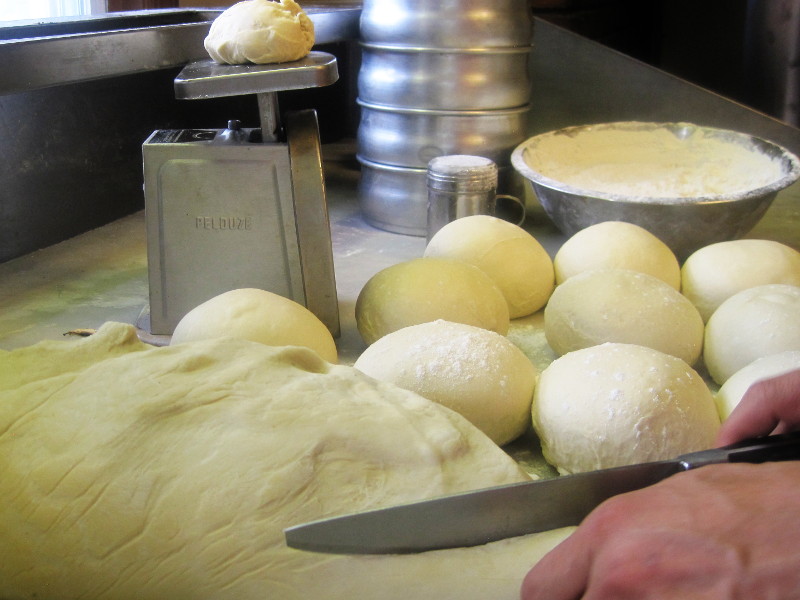
Pizza has taken on many different forms since its original inception, whether it’s a NY-Style Thin Crust pizza, Chicago-style deep dish, thick Sicilian Crust pizza, or turnover fill Calzone, Stromboli or Roll.
The first pie was invented around 1889, in Naples, Italy, and named after Queen Margherita, more about the history of Margherita Pizza.
In the US, Gennaro Lombardi started the first pizzeria in Manhattan around 1905. Since then, pizzaiolo from all around the world came up with their own twist on this popular dish, each bringing something new and interesting to the table among the most popular are chicken wings.
As the foundation of both the pizza itself and the recipe used to make it, the crust and sauce have always been the main target for pizza innovation due to their ability to entirely change your experience. Not only does it help dictate taste, texture, thickness, and topping selection on the pie, but it also affects the presentation and appearance as well.
At Anthony's Pizza, we are specialized in making Thin-crust NY-Style pizza: all old method hand-tossed technique. Somehow, after many rounds of trial and error, our Grandam emerged as the best pizza in the towns of Weehawken, Union City, West NY, and North Bergen. On a given day we sell more Grandma pies than NY-Style Pizza - this is not typical for pizzerias in the US.
A great pizza starts first with the ingredients: the DOUGH and Pizza Sauce. Old-style pizzas are baked in an oven deck with special stones for cooking the dough, side convective heat cooks the sauce and toppings, and melts the cheese. Quite important to mention that unless the stone and temperature are at an equilibrium the pizza will burn, heating a good quality pizza stone takes up to 2 hrs. Modern techniques include pan pizza or chain pizza.
Many things could go wrong with baking a pizza, to credit pizzamakers worldwide, each pizza that makes it to your table is a masterpiece:
- When the dough is opened unevenly with a small hole, the sauce and cheese would leak through and the pie ends up sticking to the stone, not only it would be difficult to separate the pizza, but cleaning the stone would: Good Luck.
- When the dough is stretched too thick, the dough won't cook, while the sauce, the cheese, and the toppings burn.
- When the dough is stretched too thin, the sauce and cheese will not bake, while the dough burns - many call it well done. No, it is burned and it's bitter!
A Well Done and crispy pie is brownish in the bottom and on the sides of the crown.
A quick breakdown of the many different types of some of the popular pizza crusts:
Thin Crust
NY-Style Pizza
Often sold by the slice - wide wedges from nearby pizzerias, NY-style pizza has been the trademark pizza of the Northeast U.S. since Lombardi first pizzeria, with local ingredients variations. The NY-style crust is slightly crunchy on the outside, yet soft and pliable enough to fold the big slices in half, making it easier for customers to eat. NY-style pizza crust gets its unique flavor and texture from its high-gluten flour and the minerals present in the water. Unlike Neapolitan pizza, NY-Style pie can take serval toppings over the entire pizza or just a half or a combination of many pizza topping halves. The flexibility of adding a variety of toppings to the thin-crust pizza makes it unique and the ideal choice for catering events and corporate food parties. To taste this pizza crust, we have made it affordable and extended pizza coupon specials.
Thin Crust
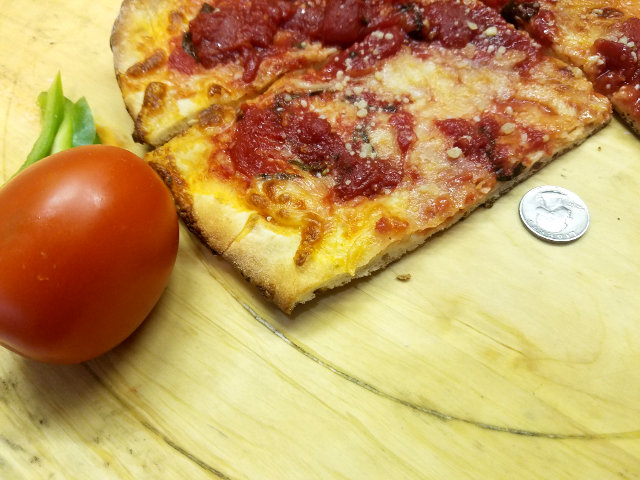
Thin Crust pizza with sauce and cheese should not be thicker than 1/8 of an inch about two stacked quarters
Lots of toppings
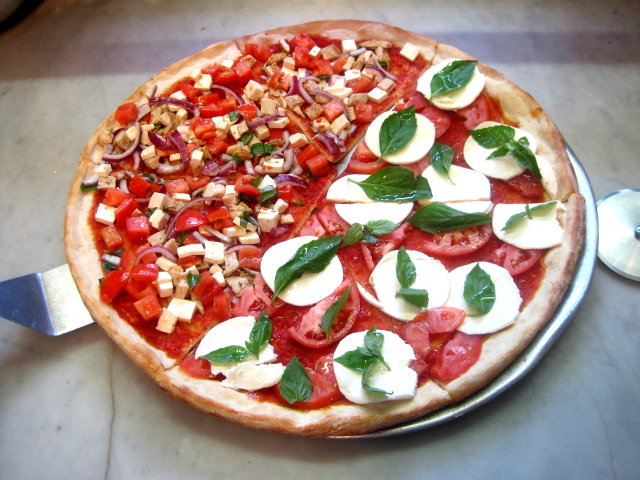
Thin crust pizza is cut into slices, each slice could have its unique flavor and toppings However, for all practical purposes select no more than 2 halves.
Add More toppings
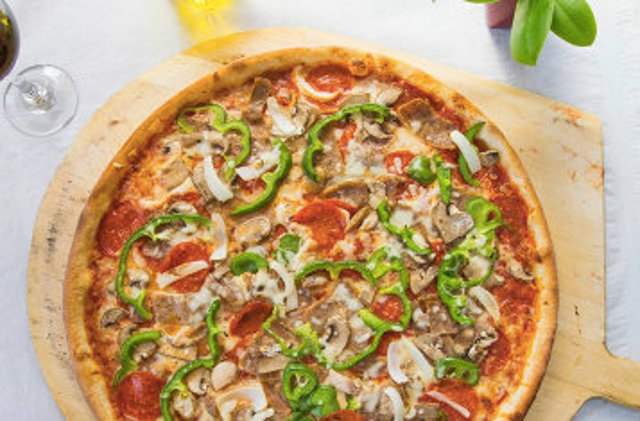
The NY-Style pizza could take the most toppings by comparison to others. For good taste 3 toppings is a good and healthy choice, 2 veggies and 1 meat. Try not to exceed 5 toppings per pie. Ok, we know that Anthony's Pizza Special has 6 toppings which is way too much!
Extra Cheese Pizza
A crazy topic with pizzerias is cheese portions, while there are many rules and guidelines. We as pizza enthusiasts like the pizza to carry the correct portion of tomato sauce and cheese. However many customers lean for extra cheese. So what's the difference and how could you tell if indeed you are getting Extra Cheese? We baked a pie with 2 halves, the left side with the correct portion of cheese and the right side with extra cheese. Keep in mind that the cheese portion is subject to people's preferences.
- The regular cheese pie (left half) should look like red marble with some orange spots.
- The extra cheese (right half) should look white with small red dots if any.
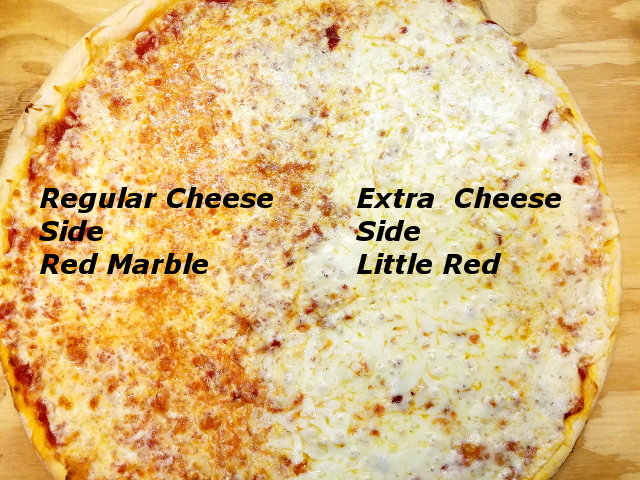
Grandma Pizza
This is a simple pie to make but a beauty by all measures. The dough could be the same as NY-Style, carefully hand-stretched on a square pan, giving it the same shape as its thick twin the Scliclian. The sauce is the masterpiece of this pizza - hand-squeezed peeled tomato with fresh basil among other ingredients. Initially, the Grandma cooked on the pan with a touch of olive oil giving it a buttery-like dough in the bottom when compared to the New-York Style (cooked on the stone throughout the baking process), however as the dough hardens, a gentle final touch on top of the stone adds the necessary crisp. This pie has been a staple for New Jersey pizzerias and is often mistaken for a Sicilian. At Anthonys Pizza, we make it good and demand surpassed the New-York Style. The authentic Grandma Pie structure requires to first laying out the cheese and then put the special sauce on top. Unlike the boring one size fits all you see at Dominos Pizza or Papa Johns Pizzerias, our pizza makers are creative with the way they lay the sauce and the basil either random or striped and that depends on their mood and the music playing in the background. Awesome as is. While this pie could take toppings we recommend care, and not to exceed 3 soft toppings as the buttery and rustic flavor may get lost with too many toppings.
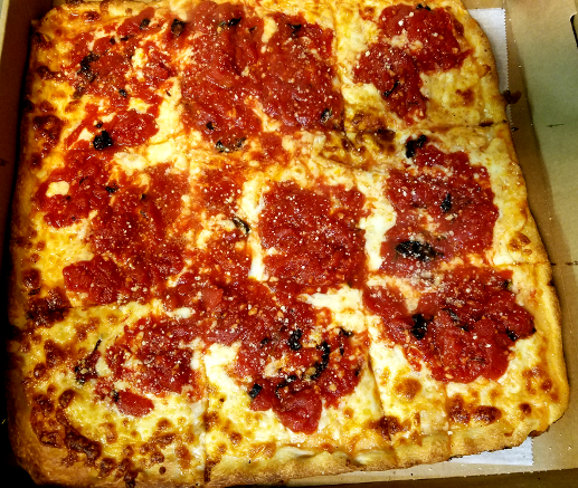
Authentic Grandma Pie
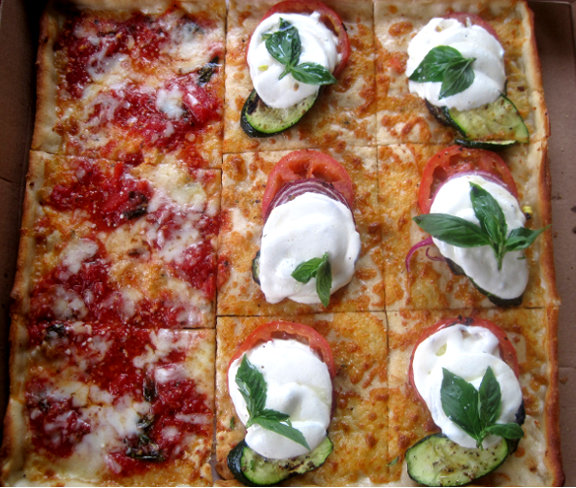
Let's be Creative with Stripes
Is Pizza Healthy or fast food?
Let's look at the healthy food pyramid
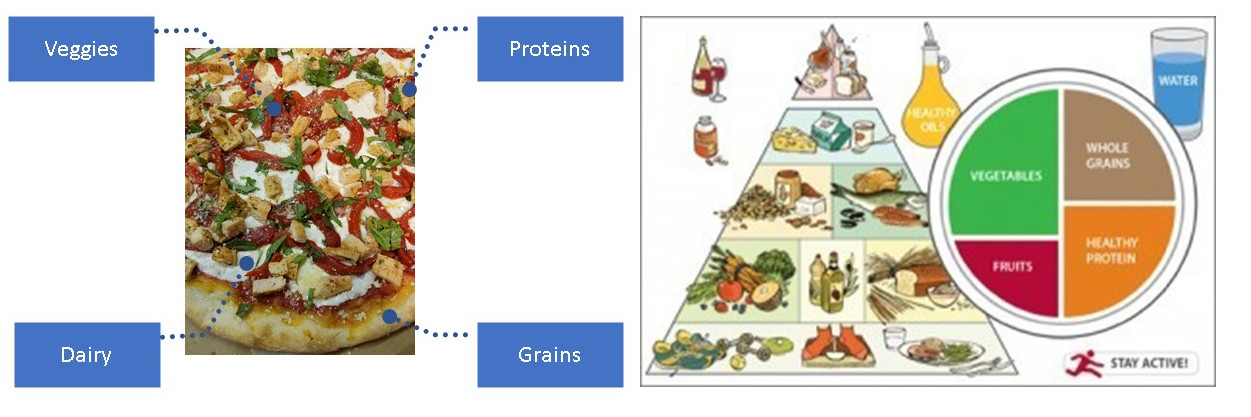
Source: Food Health Pyramid from Harvard School of Public Health
Now, is the guilt gone? Sure you must be craving our Fully Loaded Anthony's Pizza Special, Bruschetta or Genovese. We joke about it, the health pyramid resembles a wedge or a slice of pizza - tempting huh?
Neapolitan Pizza
Neapolitan pizza is credited as being the original Italian pizza. Characterized by its thin, slightly crispy texture, Neapolitan pizzas must meet a very specific set of requirements in order to truly be considered an authentic Neapolitan. A true Neapolitan is baked in a wood-fired, domed oven with dough that must be hand-kneaded (no mechanical preparation whatsoever!), no more than 35 centimeters (13.7 inches) in diameter, and no more than one-third of a centimeter (1/8 inch) thick at the center. Classic styles include the Margherita and Marinara, and given the impossible-to-replicate flavor and texture of Neapolitan crust from a wood-fired oven, this is the perfect crust for those who want an authentic Italian pizza. As this pizza is very small in size, it is usually not the best to hold enough toppings. And for family and party events, it is not the most cost-effective alternative when compared to the New York Style Thin Crust.
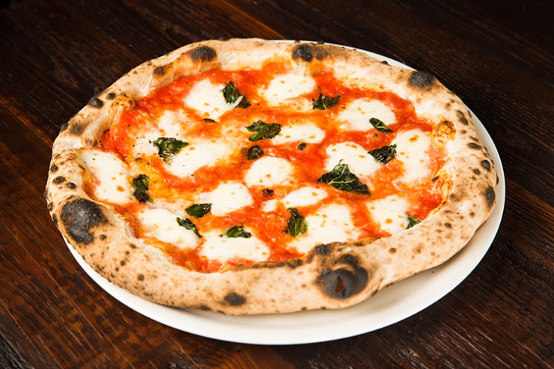
St. Louis Pizza
Another regional specialty in the Midwest, St. Louis pizza is characterized by its round, thin, unleavened, cracker-like crust and slices cut into squares or rectangles rather than wedges. This cutting style often referred to as a party or tavern cut, is very popular in Midwestern pizza parlors and bars where friends and families can gather to share a few pizzas. Unlike old-style pizza dough, St. Louis Pizzas dough does not use Yeast.
Thick Crust
Sicilian Pizza
Much different from the thin, crispy crust in Naples, Sicilian pizza is known for its thick, rectangle-shaped crust, often over an inch thick. Sicilian immigrants brought these recipes with them to the United States, and Sicilian-style pizzas are most popular in Italian-American communities throughout New Jersey, Long Island, and Boston. Depending on the region and pizzeria, many parlors let the dough rise, then pre-cook the dough, and finally spread the sauce and cheese and cook it for fast demand. Others wait for an order, then let the dough rise and cook it fresh: a much longer process and could take up to 55 min for the dough rise, and the 15 extra minutes to cook, the whole process might take 1.5hr to make a single pie. Many confuse Grandma Pizza with Sicilian they are quite different. Even though Sicilian is cooked in a 16"'x16" pan, the softness of this pizza is amazing and could be a good substitute for bread when enjoying dipping a sauce of some pasta or soup. In Sicily, many families embed Olives, Rosemary, and Garlic to this beauty and enjoy it as their daily bread: building blocks for Foccacia. It is important, however, to distinguish it from the other square-shaped Grandma Pizza, here in Union City and Weehawken we managed to restore the fame of this dolce.
Pan Pizza
Definitely not thin crust, and the least thick of the thick varieties at about half an inch, the traditional pan pizza is a happy medium for most pizza lovers. This is the style of crust that was made widely popular by Pizza Hut and is characterized by its buttery, pan-fried taste, and texture on the outside, with a soft and chewy center. It’s a crust that’s loved by people all across the country, regardless of the region, and it’s perfect for adding custom flavors.
Deep Dish Pizza
Also commonly known as the Chicago-style deep dish, this pizza’s deep ledge allows for a generous portion of toppings, cheese, and sauce, and isn’t uncommon for pizza slices to be up to 2 inches thick. The pies are baked in an oiled deep-dish pan to create a crispy, sometimes buttery, fried effect on the outside of the crust. The crust commonly contains cornmeal, semolina, or food coloring to give it its distinct yellow tone and add to its unique taste and texture. This style of pizza is particularly popular in the Midwest but almost avoided in the Northeast where New York-style and Sicilian are the preferred norm.
Focaccia
Unlike the other crusts mentioned above, focaccia is different in that it has no sauce covering it when it gets to your customers’ table. This thick, bread-like dough is brushed with olive oil before baking, then covered with cheeses, herbs, spices, and minimalistic toppings, allowing the crust’s flavor and texture to dominate. This crust is perfect as a meal accompaniment or appetizer and is great for non-traditional toppings like prosciutto and breakfast pizzas.
Flatbread Crust
Flatbread pizza has seen an uptick in popularity over the past decade or so, as American consumers start to be more health-conscious about the foods they eat. This lighter, thin-crust is ideal for appetizers and personal-sized pizzas, because it isn’t as filling as other crust types, and makes health-conscious customers feel less guilty about eating pizza. The artisan look of flatbread crust also makes them an appealing option for gourmet and trendy toppings like balsamic and spinach.
Here is a 12 min video about the history of pizza
Well we agree with most but Grandma is the thin crust while the Sicilian is much thicker
Old Fashion Home Pizza and Dough Recipe
Under the request of many of the customers that wanted us to share with them our homemade pizza, here it is! Just be considerate that this section is still under development so we will add the exact portions, pictures, and a downloadable recipe as time permits. Just stay tuned and visit us more often.
Let's be real sometimes someone feels like making their pizza at home so here is a recipe that we transferred over generations. Having said that we would like to stress two points
1) Get a pizza stone, and
2) Make sure your oven temperature could reach 450F.
In our current recipe we are adding ingredients by volume, however, measuring ingredients by weight is a much better option. So let's enjoy it!
Equipment:
- A thermometer.
- Measuring Cup
- A mixer or bowl for mixing the dough. Pizza dough is hard, so make sure your mixer could handle it!
Ingredients:
- 1 cup of water (ideally bottled pure water rich with minerals)
- 2 /14 Tea Spoons of Dry Yeast
- 1 Tea Spoon of Sugar ( Yeah this is not for the taste of weight loss it's for the Yeast)
- 3 cups of all-purpose flour
- 1 teaspoon of sea salt
- 1 Table Spoon of Olive Oil (you could go fancy with Extra Virgin but not required)
Steps:
- Bring the water to 120F
- Add 2 1/4 Tea Spoons of Dry Yeast and let
- Add 1 teaspoon of sugar and stir.
- Keep the mixture for about 10 min until the Water-Sugar-Yeast has become frothy.
- In a mixer bowl add the 3 cups of all-purpose flour and 1 Tea Spoon of Salt and mix for few seconds.
- While the mixer is running slowly and carefully add the olive oil.
- Now add the Water-Yeast Combo to the flour-salt combo and mix until the dough forms a ball (kind of uniform structure)
- In a clean bowl spray some olive oil and transfer the dough ball
- Cover with a lid, or plastic wrap.
- Let the dough rest until it doubles in size. (Typically, in a fridge it's typically 12hrs, at ambient room temperatures about 3 to 4 hrs, in a hot day. 90F or above, 2 hrs is sufficient)
- How to hand stretch your pizza - that's a challenge!